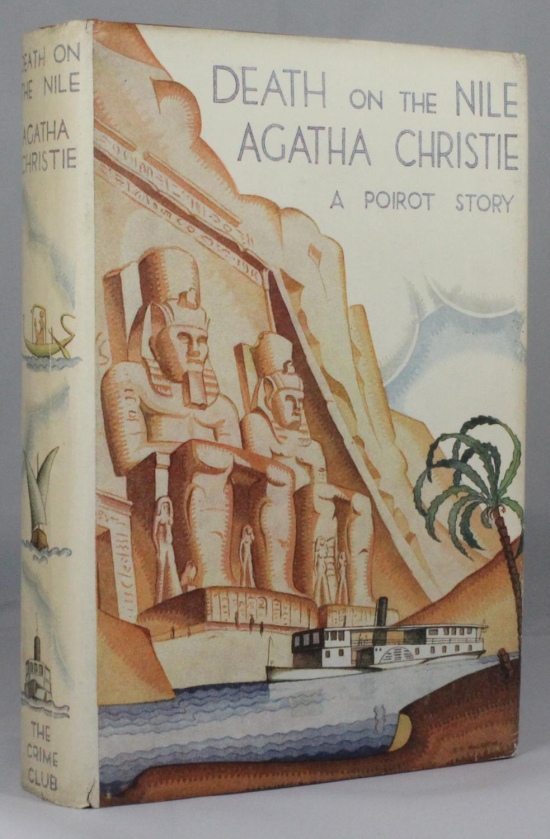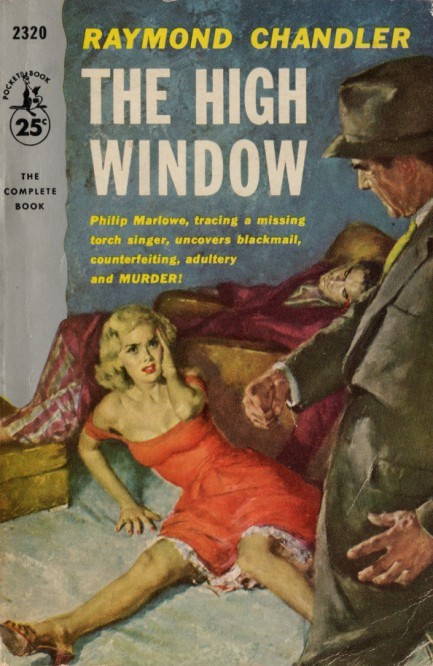Twentieth-century detective novels are intimately tied to the history of the pulps. Many works we now consider classics in the genre first appeared in mystery pulp magazines, such as Hammett’s Maltese Falcon in The Black Mask. But “pulp” is a wide category that bounds across genres. Their common traits are cheapness, portability, and popularity. And that last feature was often stoked by the sensational. Entire genres of pulp rely on the erotic for their appeal. No matter how unsexy some of them may be, detective stories, with their pulp ancestry, were often ripe for exploitation. As a result, ridiculously sexified covers of books often appeared that were far racier than the actual book.
The text right under the title on the cover of this 1945 edition of The Maltese Falcon, for example, features the only sexually scandalous scene of the book, as if it were the single most crucial moment of the entire story: “Sam Spade searched each article of the girl’s clothing.”
 Pocket Books, 1945.
Pocket Books, 1945.
And in this 1957 edition, the character summary for Brigid O’Shaughnessy on the back cover reads: “…who’d come from the Orient and knew where the statue was. She hired Spade. And then took him to bed to stop his questions.”
 Permabooks, 1957. Cover artist: Stanley Meltzoff.
Permabooks, 1957. Cover artist: Stanley Meltzoff.
Yet here is the cover of the first edition in book form (Knopf, 1930):
 First edition in book form, Knopf, 1930. Image courtesy Royal Books.
First edition in book form, Knopf, 1930. Image courtesy Royal Books.
Jacket copy inevitably oversimplifies a story to sell it in a small space. But, as the first edition cover indicates, the choice to rely upon erotic sensationalism feels laughably unnecessary. Yet these absurd covers speak to the detective novel’s unavoidable shared heritage with other sensational pulp genres, much like the ever-present creepy uncle at Thanksgiving.
Here’s a group of classic crime novels in a compare and contrast: the first edition cover and a “sexy” pulp cover.
The Hound of the Baskervilles, Arthur Conan Doyle
 First edition in book form. George Newnes, 1902.
First edition in book form. George Newnes, 1902.
 Bantam, 1949. Cover artist: William Shoyer.
Bantam, 1949. Cover artist: William Shoyer.
The Mysterious Affair at Styles, Agatha Christie
 First edition. Bodley Head, 1921. Image courtesy Lucius Books.
First edition. Bodley Head, 1921. Image courtesy Lucius Books.
 Avon, 1951. Cover artist: Barye Phillips.
Avon, 1951. Cover artist: Barye Phillips.
Death on the Nile, Agatha Christie
 First edition. Crime Club, 1937. Cover artist: Robin Macartney.
First edition. Crime Club, 1937. Cover artist: Robin Macartney.
 Avon, 1951.
Avon, 1951.
The Thin Man, Dashiell Hammett
 First edition. Knopf, 1934. Image courtesy Captain Ahab’s Rare Books
First edition. Knopf, 1934. Image courtesy Captain Ahab’s Rare Books
 Horwitz, 1961.
Horwitz, 1961.
The Big Sleep, Raymond Chandler
 First edition. Knopf, 1939. Image courtesy Biblioctopus.
First edition. Knopf, 1939. Image courtesy Biblioctopus.
 Pocket Book, 1958. Cover artist: Darcy.
Pocket Book, 1958. Cover artist: Darcy.
High Window, Raymond Chandler
 First edition. Knopf, 1942.
First edition. Knopf, 1942.
 Pocket Book, 1945. Cover artist: E. McKnight Kauffer.
Pocket Book, 1945. Cover artist: E. McKnight Kauffer.
The Postman Always Rings Twice, James M. Cain
 First edition. Knopf, 1934. Cover artist: Arthur Hawkins, Jr. Image courtesy Between the Covers.
First edition. Knopf, 1934. Cover artist: Arthur Hawkins, Jr. Image courtesy Between the Covers.
 Caption: Pocket Book, 1947. Cover artist: Tom Dunn.
Caption: Pocket Book, 1947. Cover artist: Tom Dunn.




















